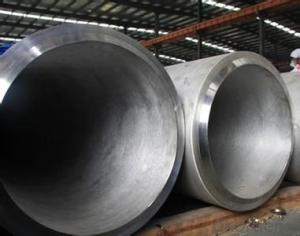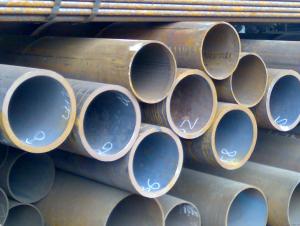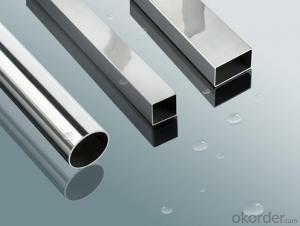API 5L Thick Wall Seamless Stainless Steel Tube
- Loading Port:
- Tianjin
- Payment Terms:
- TT or LC
- Min Order Qty:
- 25 m.t.
- Supply Capability:
- 10000 m.t./month
OKorder Service Pledge
OKorder Financial Service
You Might Also Like
We are company that have many years experience and professional manager team and engineer team and sales team, sure we will provide you high quality of pipe and professioanl service.
Seamless pipe possesses a hollow section and without seam around the strip steel. It is made with solid bar or steel ingot by perforating machine. As the facture process does not include any welding, seamless pipes are considered to be stronger and more durable. Generally speaking, seamless pipe has better pressure resistance and security than other classifications, and was usually more easily available than welded pipe.
2、Main Features of the Seamless Pipe:
• High working accuracy
• High strength
• Small inertia resistance
• Strong therming dissipine ability
• Good appearance
• Reasonble price
3、Seamless Pipe Specification:
Standard | GB, DIN, ASTM ASTM A106-2006, ASTM A53-2007 |
Grade | 10#-45#, 16Mn 10#, 20#, 45#, 16Mn |
Thickness | 8 - 33 mm |
Section Shape | Round |
Outer Diameter | 133 - 219 mm |
Place of Origin | Shandong, China (Mainland) |
Secondary Or Not | Non-secondary |
Application | Hydraulic Pipe |
Technique | Cold Drawn |
Certification | API |
Surface Treatment | factory state or painted black |
Special Pipe | API Pipe |
Alloy Or Not | Non-alloy |
Length | 5-12M |
Outer Diameter | 21.3-610mm |
Grade | 20#, 45#, Q345, API J55, API K55, API L80, API N80, API P110, A53B |
Standard | ASME, ASTM |
1) Material:20#(ASTM A 106/A53 GRB.API5LGRB,GB),45#,16Mn,10#.
2) Specification range: OD: 21.3-610mm, WT:6-70mm, length:6-12m or according to the requirement of clients.
3) Executive standards: GB, ASME API5L.ASTM A 106/A53,Despite of the above standards, we can also supply seamless steel pipe with standard of DIN, JIS, and so on, and also develop new products according to the requirements of our clients!
4) Surface: black lacquered, varnish coating or galvanized.
5) Ends: Beveled or square cut, plastic capped, painted.
6) Packing: bundles wrapped with strong steel strip, seaworthy packing.
4、Packaging & Delivery:
Packaging Details: | seaworthy package, bundles wrapped with strong steel strip |
Delivery Detail: | 15-30days after received 30%TT |
5、FAQ of Seamless Pipe:
①How is the quality of your products?
We have many years business experience in this area, and we have professional engineer and manager team and sure we can provide you high quality production and professional service.
②How about price?
Yes, we are factory and be able to give you lowest price below market one, and we have a policy that “ for saving time and absolutely honest business attitude, we quote as lowest as possible for any customer, and discount can be given according to quantity”,if you like bargain and factory price is not low enough as you think, just don’t waste your time.Please trust the quotation we would give you, it is professional one.
③Why should you chose us?
We can give you both.Additionally, we can also offer professional products inquiry, products knowledge train(for agents), smooth goods delivery, exellent customer solution proposals.Our service formula: good quality+good price+good service=customer’s trust
SGS test is available, customer inspection before shipping is welcome, third party inspection is no problem.
6、Seamless Pipe Images:
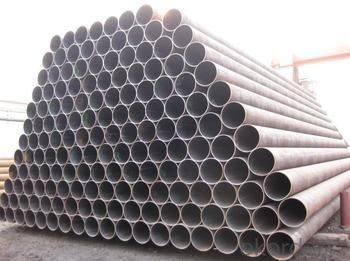
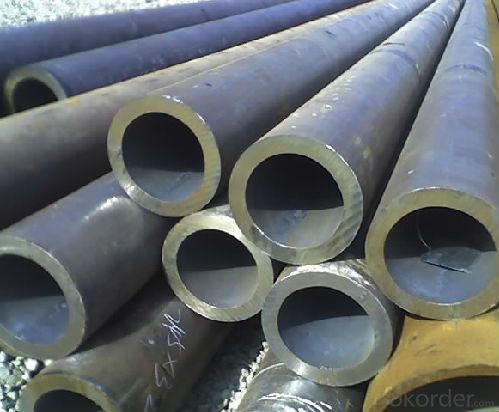
- Q:What is the difference between 304LN and 304 stainless steel pipes?
- The main difference between 304LN and 304 stainless steel pipes lies in the nitrogen content. 304LN stainless steel contains a higher nitrogen content, which improves its strength and corrosion resistance compared to 304 stainless steel. This makes 304LN a better choice for applications where high strength and resistance to corrosion are important factors.
- Q:What are the standard sizes for stainless steel pipes?
- The standard sizes for stainless steel pipes vary depending on the application and industry. However, commonly used standard sizes range from 1/8 inch to 24 inches in diameter, with wall thicknesses ranging from Schedule 5S to Schedule XXS.
- Q:Can stainless steel pipes be used for pharmaceutical industries?
- Yes, stainless steel pipes can be used for pharmaceutical industries. Stainless steel is a preferred material choice in pharmaceutical applications due to its high corrosion resistance, durability, and hygienic properties. It is commonly used for transporting pharmaceutical liquids, gases, and chemicals in a safe and sterile manner, making it suitable for pharmaceutical manufacturing and processing operations.
- Q:What is the difference between 304J5 and 316J5 stainless steel pipes?
- The main difference between 304J5 and 316J5 stainless steel pipes lies in their composition. While both are stainless steels, 304J5 contains a higher percentage of chromium and nickel, making it more corrosion resistant than 316J5. On the other hand, 316J5 contains a small amount of molybdenum, which enhances its resistance to pitting and crevice corrosion. Therefore, if corrosion resistance is of utmost importance, 304J5 would be the preferred choice, whereas if added resistance against pitting and crevice corrosion is desired, 316J5 would be the better option.
- Q:What is the difference between 410 and 316 stainless steel pipes?
- The main difference between 410 and 316 stainless steel pipes lies in their chemical composition and their intended applications. 410 stainless steel is a martensitic stainless steel, which means it has a high carbon content (between 0.15% and 0.25%) and a relatively low chromium content (between 11.5% and 13.5%). This composition gives 410 stainless steel pipes excellent strength, hardness, and wear resistance. It is often used in applications where corrosion resistance is not the primary concern, such as in cutting tools, knives, and firearm components. On the other hand, 316 stainless steel is an austenitic stainless steel with a higher chromium content (between 16% and 18%) and a significant amount of nickel (between 10% and 14%). This composition gives 316 stainless steel pipes excellent corrosion resistance, especially in environments with chlorides or other corrosive agents. It is widely used in industries such as chemical processing, pharmaceuticals, food processing, and marine applications. In summary, the main difference between 410 and 316 stainless steel pipes is their chemical composition and the resulting properties. 410 stainless steel offers superior strength and hardness but has lower corrosion resistance compared to 316 stainless steel, which is highly corrosion resistant but may have slightly lower strength and hardness. The choice between the two depends on the specific requirements of the application, with 410 stainless steel being more suitable for applications where strength and wear resistance are crucial, and 316 stainless steel being preferred for applications requiring excellent corrosion resistance.
- Q:Can stainless steel pipes be used for oil refinery applications?
- Yes, stainless steel pipes can be used for oil refinery applications. Stainless steel is widely used in the oil and gas industry due to its excellent corrosion resistance properties, high strength, and durability. Oil refineries deal with harsh and corrosive environments, including high temperatures, pressure, and exposure to various chemicals. Stainless steel pipes can withstand these conditions and offer long-lasting performance. Stainless steel pipes are resistant to corrosion caused by acidic and alkaline substances, which are commonly found in oil refinery operations. They also have good resistance to pitting and crevice corrosion, making them suitable for handling crude oil, petroleum products, and other corrosive media. Furthermore, stainless steel pipes can handle high temperatures without losing their strength and integrity. This is important in oil refineries where processes involve heating and cooling operations. In addition to corrosion resistance and high-temperature capabilities, stainless steel pipes also provide excellent mechanical properties. They are strong, durable, and have good weldability, making them suitable for the demanding conditions of oil refinery applications. Overall, stainless steel pipes are a reliable choice for oil refinery applications due to their corrosion resistance, high-temperature capabilities, and mechanical properties. They ensure the safe and efficient transportation of oil and petroleum products, contributing to the smooth operations of oil refineries.
- Q:Can stainless steel pipes be used in the renewable energy industry?
- Yes, stainless steel pipes can definitely be used in the renewable energy industry. Stainless steel is a highly versatile and durable material that offers numerous advantages for various applications in renewable energy systems. One of the key benefits of stainless steel pipes is their exceptional corrosion resistance. This makes them ideal for use in environments where exposure to moisture, chemicals, and other corrosive elements is common, such as in solar power plants, geothermal energy systems, and offshore wind farms. Stainless steel pipes can withstand these harsh conditions and maintain their structural integrity over long periods, reducing the need for frequent repairs and replacements. Another advantage of stainless steel pipes is their high strength-to-weight ratio, which allows for the design of lightweight and efficient renewable energy structures. Stainless steel pipes can be used in the construction of support frames, structures, and pipelines for wind turbines, solar thermal collectors, and biomass power plants, among others. Their strength and durability contribute to the overall reliability and longevity of the renewable energy systems. Furthermore, stainless steel pipes are resistant to extreme temperatures, making them suitable for use in high-temperature applications like concentrated solar power systems. These pipes can handle the intense heat generated by solar receivers without undergoing deformation or degradation, ensuring the efficient transfer of heat in the system. In addition to their mechanical properties, stainless steel pipes are also hygienic and environmentally friendly. They are easy to clean and maintain, reducing the risk of contamination and ensuring the purity of fluids in renewable energy processes. Stainless steel is also a recyclable material, aligning with the sustainability principles of the renewable energy industry. Overall, stainless steel pipes offer a reliable, long-lasting, and cost-effective solution for various applications in the renewable energy industry. Their corrosion resistance, strength, temperature resistance, and environmental benefits make them an excellent choice for transporting fluids, supporting structures, and withstanding the demanding conditions of renewable energy systems.
- Q:304 stainless steel pipe, 20*2 pressure, how many kilograms?
- 304 is a versatile stainless steel which is widely used in the manufacture of equipment and parts requiring good overall performance (corrosion resistance and formability).
- Q:How is stainless steel pipe different from carbon steel pipe?
- Stainless steel pipe and carbon steel pipe are two popular materials used in various industries for different applications. The main difference between these two types of pipes lies in their composition, corrosion resistance, and price. Firstly, stainless steel pipe is made up of an alloy of iron with a minimum of 10.5% chromium content. This addition of chromium forms a protective layer of chromium oxide on the surface of the pipe, which significantly enhances its corrosion resistance. On the other hand, carbon steel pipe is primarily composed of iron and carbon, with no additional alloying elements. This lack of alloying elements makes carbon steel pipe more susceptible to corrosion, especially when exposed to moisture or harsh environments. Secondly, stainless steel pipe is highly resistant to corrosion and rust, making it suitable for applications where the pipe needs to withstand harsh conditions or exposure to corrosive substances. Carbon steel pipe, on the other hand, is more prone to corrosion and may require additional protective coatings or treatments to prevent rusting. Lastly, the price of stainless steel pipe is generally higher than that of carbon steel pipe. This is mainly due to the added chromium content and the superior corrosion resistance it provides. Carbon steel pipe, being a more basic and common material, is generally more affordable and widely available. In summary, the key differences between stainless steel pipe and carbon steel pipe lie in their composition, corrosion resistance, and price. Stainless steel pipe offers superior corrosion resistance and durability, making it ideal for applications where corrosion is a concern. Carbon steel pipe, although less resistant to corrosion, is more affordable and widely used in various industries. The choice between these two types of pipes ultimately depends on the specific requirements, budget, and environmental conditions of the intended application.
- Q:What is the difference between seamless and longitudinal welded stainless steel pipes?
- The manufacturing processes and structural characteristics of seamless and longitudinal welded stainless steel pipes vary. Seamless pipes, for instance, are formed by heating a solid cylindrical bar of stainless steel and pushing it through a die to create a hollow tube. This process eliminates the need for welded seams, resulting in a uniform composition and consistent strength and corrosion resistance. As a result, seamless pipes are commonly used in high-pressure applications like oil and gas pipelines and refinery equipment due to their superior mechanical properties. In contrast, longitudinal welded pipes are made by joining two separate pieces of stainless steel plate or sheet together through a longitudinal welding process. The plates or sheets are rolled into a cylindrical shape, and the seam is welded along the length of the pipe. This welding technique provides structural integrity and strength to the pipe, although it may introduce some slight inconsistencies in the steel's composition and properties. However, these inconsistencies can be minimized through appropriate welding techniques and quality control measures. Longitudinal welded pipes are widely used in various fields, including structural and architectural projects, as well as in industries such as food processing, pharmaceuticals, and petrochemicals. In conclusion, the main distinction between seamless and longitudinal welded stainless steel pipes lies in their manufacturing methods and resulting structural characteristics. Seamless pipes have no welded seams and offer excellent mechanical properties, making them suitable for high-pressure applications. On the other hand, longitudinal welded pipes are created by welding two separate stainless steel pieces together and are commonly utilized in different industries. The choice between these types of pipes depends on specific requirements and considerations for the intended application.
1. Manufacturer Overview |
|
|---|---|
| Location | |
| Year Established | |
| Annual Output Value | |
| Main Markets | |
| Company Certifications | |
2. Manufacturer Certificates |
|
|---|---|
| a) Certification Name | |
| Range | |
| Reference | |
| Validity Period | |
3. Manufacturer Capability |
|
|---|---|
| a)Trade Capacity | |
| Nearest Port | |
| Export Percentage | |
| No.of Employees in Trade Department | |
| Language Spoken: | |
| b)Factory Information | |
| Factory Size: | |
| No. of Production Lines | |
| Contract Manufacturing | |
| Product Price Range | |
Send your message to us
API 5L Thick Wall Seamless Stainless Steel Tube
- Loading Port:
- Tianjin
- Payment Terms:
- TT or LC
- Min Order Qty:
- 25 m.t.
- Supply Capability:
- 10000 m.t./month
OKorder Service Pledge
OKorder Financial Service
Similar products
New products
Hot products
Hot Searches
Related keywords
